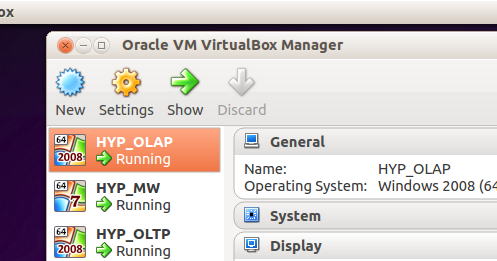

They will have access to anything outside, but nothing can get in. Set the VMs up as NAT to keep them private. I take this to mean the physical machines will be on the public network 192.168.3/24 and the virtuals will be in a private network as 10.0.1/24 to protect services from the public network? You can create as many isolated test environments as you want by creating a new host-only adapter for each group. Any test VMs you want to make, be sure that they bind to that host-only adapter & they won't be able to route out past the 10.0.1.1 gateway. You can create a host-only adapter in VirtualBox settings which has the 10.0.1.1 IP, then have it hand out DHCP (no need to set statics unless you want to). Is this correct way to do it? After building more VMs, do I configure them also with "internal" NICs and make 10.0.1.1 as their gateway? So far I've set up VM for 2008 server with two NICs - bridged (to Production LAN) and Internal (to internal LAN) - both static as shown in Scenario. One Server 2008 should act as a router for Internal LAN computers. I will need access to the Production LAN and Internet-via-Production LAN.

ORACLE VIRTUALBOX INTERNAL NETWORK WINDOWS 7
I'd like to setup a separate network (some 2008/Windows 7 computers) using Oracle Virtualbox on Windows 7 host. However, after only a couple of hours, you will have a totally private network within the physical servers that can be accessed through port forwarding - perfect for things like web apps - and no chance of direct access to the database. You will need to do a little planning and a little setup at the beginning for it to work as you'd like. This is not going to be an "automatic" configuration.

Also, you should determine your numbering scheme in advance and use the local hosts file so all VMs have a name-to-address and address-to-name map for machines that are not in DNS. You should look at the IP and routing of a DHCP guest VM to determine what the correct settings should be and make them static to avoid problems. Because of the way the NAT engine works, there is no guarantee that each VM will receive the same IP every time it boots. As I said in my earlier post, you may need to assign IPs to the VMs statically. In particular, there is a section in Chapter 9 on fine tuning the NAT engine. You should read Chapter 6 "Virtual Networking" and Chapter 9 "Advanced Topics" of the VirtualBox online help. You may need to adjust the IP range using VBoxManage. I am 99.99% sure the NAT engine on the other interface (in the same network) will handle all of the IPs by way of DHCP. If you do need a second NIC, the VMs should have a secondary NIC bridged to this interface. You may not need this, depending on how your physical hosts are connected and also what OS and services are running on the VMs. If you have two or more physical servers running multiple VMs in the same private network, then each physical server may need to have a second NIC configured in the private network so the VMs inside physical host-A can communicate with the VMs inside physical host-B using only the private network. Meanwhile, if the VMs are running a web based application with a database inside the private network, ONLY the web traffic will ever be seen outside the private network. If you have 10 VMs running, you can use different ports to forward different traffic. You cannot access the VM directly, but you go through the physical host. Now, when you start the VM, you could open a web browser pointing to https:/ / 192.168.3.100:443 that will be redirected to the VM. Then, the Host IP and port should be filled in (example, IP=192.168.3.100, port=443) as well as the Guest IP and port (example, IP=10.0.1.10, port=443). The protocol must be either TCP or UDP, but most things will be TCP. You must give the rule a name (default is "Rule 1" but you should change that to something significant). At the bottom of the section, click on PortForwarding. Then, in the Network section of the VM settings, click on Advanced. You should set up primary VM networking as NAT and bind it to this NIC on the physical server.

I think the physical host should have its normal IP as 192.168.3.100/24.


 0 kommentar(er)
0 kommentar(er)
